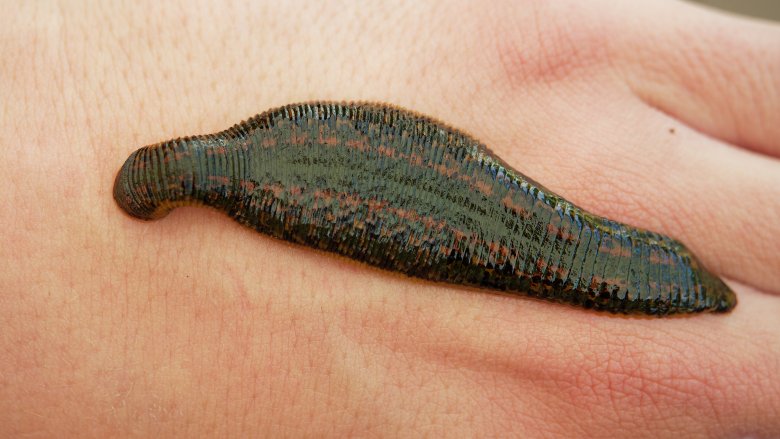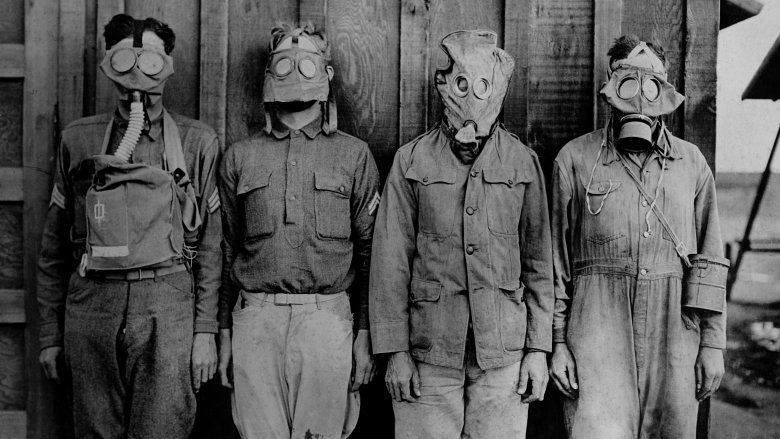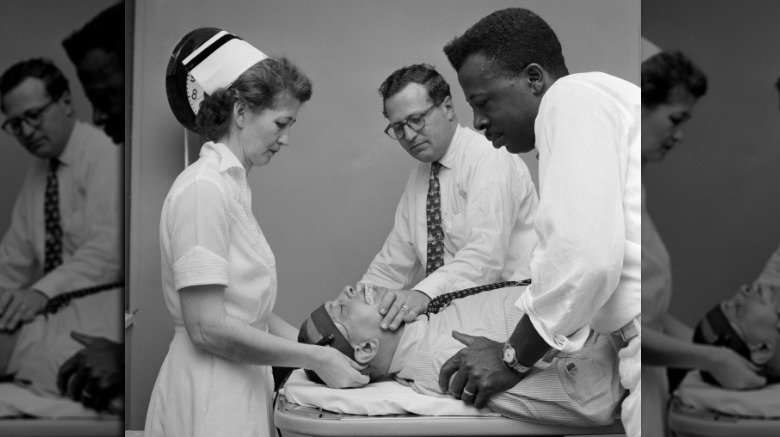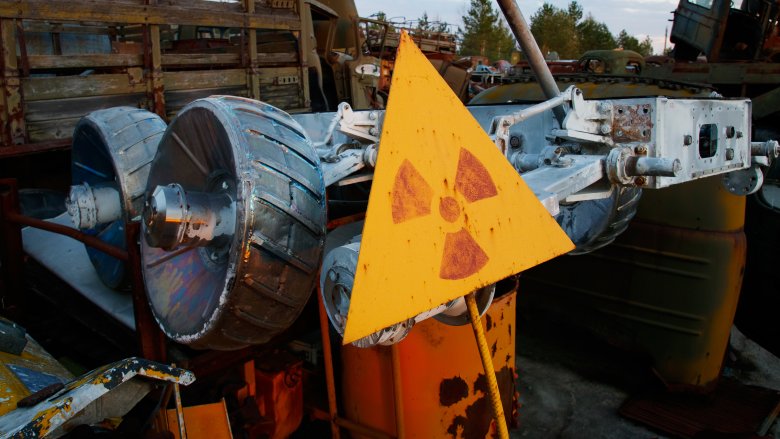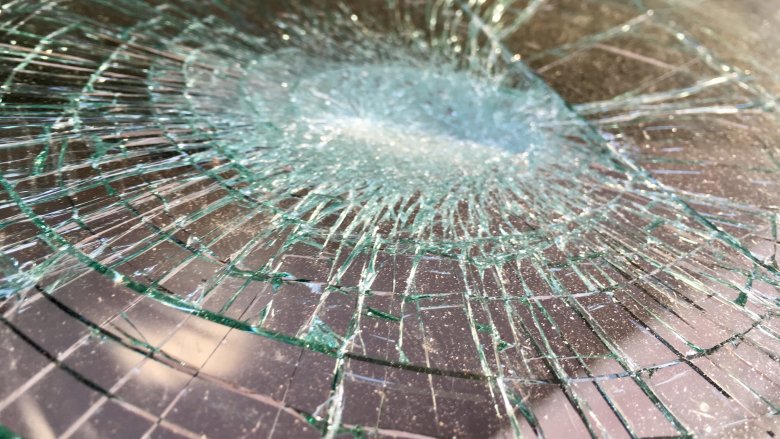Crude Practices That Led To Great Discoveries
Once, not so very long ago, people threw their poop out their windows, thought smoking was good for the body, and never washed their hands. It was good times for tobacco companies and hard times for soap manufacturers, but we like to think we've learned some things from our gross and crude habits of the past. Like, wash your hands and don't throw your own excrement on random passers-by.
But some of the crude practices of the past have actually led to great discoveries — a few of them so great that they've saved lives and changed medicine/science/history as we know it. So the next time you embarrass yourself with a dumb mistake in front of everyone you love, try to remember these crude, yet monumental moments in history and just be grateful that your mistakes have never landed you in a textbook, thus forever immortalizing your stupidity in the guise of great scientific achievement.
In case you needed another reason to dislike hospitals
For centuries, people treated pretty much every illness with bloodletting. Stomach ache? Don't worry, we'll just slice you open with a dirty knife and let you fill a couple of goblets with O negative. Acne? Let's cover your face with bloodsucking leeches because that's way more attractive than pimples.
According to the BC Medical Journal, bloodletting as a medical treatment has been around for 3,000 years, and for some reason over the course of that entire 3,000 years it never occurred to anyone that they should maybe find out if bloodletting ever fixed anyone.
Disturbingly, it turns out that bloodletting wasn't entirely without merit, and by the late 20th century, people had figured out that the bloodletting leech wasn't just a way for medieval doctors to torment patients who were probably going to die anyway. The common "medicinal" leech has certain substances in its secretions that actually possess therapeutic properties. Hirudin, for example, is an anticoagulant that leeches use to make sure that your blood doesn't clot en route to their bellies. It was first used medicinally in 1909 and today is used to treat deep-vein thrombosis. And in case you're curious, some people still use leeches to treat acne, though it doesn't seem to be something that most doctors recommend.
Solar energy was invented to keep crappy technology online
As far as sustainable energy goes, solar is about as modern as it gets. Climate scientists dream of a world powered by solar farms, where we can all binge TV for hours, do laundry at 2 p.m., and keep our air conditioners set to 68 without having to worry that our sloth will eventually lead to the destruction of Earth. But here's a funny thing about solar power — according to SolarEnergy.com, the first solar technology was developed in the late 1800s, when crude technology ruled the world. During the Industrial Revolution, fossil fuel supplies seemed bottomless, and people were quite happy to pollute the air in the name of keeping those giant, worker-maiming factories operating. But there were a handful of engineers who wondered if maybe the world's supply of fossil fuels wasn't bottomless, so they set about trying to develop something renewable while the rest of the world's engineers laughed and pointed at them.
One inventor in particular — a mathematician named Auguste Mouchout — even got as far as building a solar motor that boiled water. Mouchout hoped his invention would replace coal as the energy source powering the world's still crude and dangerous steam engines, which is pretty ironic when you consider that something as modern as a solar motor was designed not to help replace dangerous and unpredictable steam-powered machinery but to keep it running.
You don't mind if I get my corpsey hands all over your newborn, do you?
There was once a time when hand washing was quaint, and you probably know some 13-year-old who really wishes he still lived in those times. But most doctors probably aren't among those who sneak out of restrooms without washing up because doctors understand the lethal power of bacteria. It hasn't always been that way, though.
According to NPR, in 1846 a doctor named Ignaz Semmelweis noticed that a maternity ward staffed by doctors and medical students had a mortality rate five times higher than a maternity ward in the same hospital staffed by midwives. At some point it occurred to him that the staff in the death ward were performing autopsies in the morning and delivering babies in the afternoon, while the midwives were just delivering babies. Perhaps, he theorized, "cadaverous particles" were getting passed from the doctors' hands to laboring women. He ordered physicians to start washing their hands, and the death rate dropped dramatically.
But then doctors were all, "He's totally blaming us for killing people. We're not going to wash our hands anymore. That will show him." So they stopped washing their hands, the death rate went back up, and Semmelweis got fired. He eventually ended up in a mental institution where he got the crap beaten out of him and died, rather ironically, from sepsis. But doctors did eventually figure out that he was right. Eventually.
That time when clear-cutting had an awesome side effect
There is (hopefully) no one left on Earth who will argue that clear-cutting is a good thing. Even the people who clear-cut know it's not a good thing, it's just that money speaks louder than environmental scientists. But something good did come out of the practice — according to The New Yorker, satellite imagery in 2010 revealed the remnants of an ancient civilization in a recently cleared part of the upper Amazon basin. Archaeologists identified at least 210 sophisticated structures across more than 150 miles.
It was rather belated news for all the early 20th-century explorers who died in search of the mythical "El Dorado." In those days, most people thought it was impossible for humans to build cities deep within the Amazon, simply because it was such a hostile place. But as it turns out, explorers like Percy Harrison Fawcett, who disappeared in 1925 trying to find the lost city, might have almost been on the right track.
The civilization revealed in 2010 was remarkably geometric, with earthworks built as perfect circles or rectangles and roads precisely spaced like modern city blocks. Some of these cities were large enough to support up to 5,000 people, which frankly makes all the naysayers look like way bigger whack-jobs than guys like Fawcett. And the discovery wouldn't have been possible without clear-cutting, although clear-cutting still sucks and please stop doing it.
That time when an agent of chemical warfare turned out to be a life-saving drug
In what is perhaps the world's only example of chemical warfare doing more good than harm, the crude practice of killing people with mustard gas led directly to a life-saving cancer therapy. So, yay chemical warfare?
According to History, in 1917, the Germans introduced mustard gas to the battlefield — named for its color and odor, not because it was made from the same condiment we like to put on our hot dogs. Mustard gas caused horrible blistering on both the outside and inside of soldiers who were exposed to it. During World War II, researchers were testing similar nitrogen mustards as potential weapons when they noticed that people who were exposed to them had low white blood cell counts. That led scientists to wonder if instead of killing people, maybe they could actually save people.
Two Yale pharmacologists decided to answer the question in 1940 by first treating mouse tumors with mustard agents and then testing them on a patient who was suffering from non-Hodgkin's lymphoma. The patient's tumors shrunk, and chemotherapy was born. If you need some perspective on just what this breakthrough meant for cancer patients all over the world — during World War I, chemical warfare of all kinds was responsible for roughly 30,000 deaths, while chemotherapy has likely saved the lives of millions, or at the very least added some good years onto lives that would have otherwise been cut short.
When two mental illnesses have a psychiatric fist-fight
Not so long ago, psychiatric hospitals could do horrible things in the name of "treatment" and "research" because no one really thought it counted as bad if it happened to a crazy person. Back in the 1930s there was this guy named Ladislaus von Meduna, who believed there was a "biological antagonism" between the brains of schizophrenics and epileptics, and don't ask why he thought that because it makes no sense no matter what century you're from. Anyway from that, he posited that psychologists might be able to treat one by inducing symptoms of the other, so that's what he did, testing a few different drugs before settling on one called metrazol. Eventually his weird theory about mental disorders not liking one another was debunked, but in the meantime he'd shown that induced seizures did seem to have some sort of therapeutic effect.
But according to Scientific American, metrazol was awful. Patients on metrazol experienced terror, and some of them had to be cornered and forced to take it. So psychiatrists felt compelled to come up with something better, and that's when someone got the idea to induce seizures with electricity instead, and that came with its own set of horrors, until the technique was refined into the medically accepted practice it is today.
Don't worry about that nuclear meltdown. Here, have a mushroom.
Failure to obtain informed consent is at the root of a pretty significant number of the world's evils. During the industrial revolution, for example, people were routinely killed due to the negligence of their employers and the insidious machinery they were working with, and for decades smokers weren't told that their cigarettes might kill them.
In the 1980s there was a nuclear accident at Chernobyl, and the Russian government decided it was best to maybe not rush people into an evacuation because they didn't want to look guilty as hell. According to History, it took more than a day for them finally start evacuating the 50,000 people living in nearby Pripyat, and people in the surrounding areas were kept in the dark — no one administered potassium iodide, which is now standard procedure for radiation exposure, and people were basically told to carry on living their lives as usual and to do seriously questionable stuff like eat the local mushrooms.
It seems awful to say that a nuclear disaster could have a silver lining, but it did — medical science in general gained a lot of its current knowledge about radiation exposure from Chernobyl patients, and pretty much everything we know about how to prepare for a nuclear disaster came from those dark days in Russia. And today, Pripyat and Chernobyl are must-see tourist destinations so, you know, there's also that.
Your pee could change the world
If you define "crude" as seriously disgusting, here's a really crude thing that led to a great discovery: some dude peeing into beakers and then collecting pee from other people and putting it into beakers and then somehow ending up with 1,500 gallons of other people's pee that he could then put into more beakers.
Hennig Brand was an alchemist, and he called himself "Doctor Brand" though like his TARDIS-flying counterpart no one knew exactly why he was qualified for the title. Doctor Brand, who lived in the 1600s, got his pee-as-a-chemical-of-scientific-interest ideas from a book on alchemy, which said that a mixture of concentrated human urine plus a couple other ingredients could turn base metals into gold, and he apparently never wondered whether the author of the book just wrote that so he could laugh hysterically at the thought of someone peeing into beakers.
Because this already isn't gross enough, Gizmodo says Doctor Brand let the urine stew in the hot sun for weeks until it was disgusting and then he boiled it until it was more disgusting and then he extracted and mixed together all the most disgusting parts and eventually ended up with a "shining, white liquid" that burst into flames when exposed to oxygen. His discovery was phosphorus, which is used today to make weapons and also fireworks, so boo and yay respectively. Alchemy, baby!
Also, your laziness could change the world
And finally, here's a story of how just one person's crude practices can save millions of lives totally by accident.
In the early years of the 20th century, a French scientist named Edward Benedictus knocked over a beaker. Fortunately, the beaker was not filled with someone else's pee, but it did behave pretty strangely for a broken beaker. Instead of shattering into a million tiny pieces that would still appear at random moments to slice open his hands no matter how thoroughly he swept it up, the glass cracked ... but maintained its shape.
According to Penn State University, Benedictus later found out that his lab assistant had been doing a crap job at cleaning the glassware, and the inside of the beaker was coated with cellulose nitrate, which formed a thin film on the inside when it dried. The accidental discovery led to the invention of safety glass, which is the main reason we don't get shredded by broken glass when we're unlucky enough to be involved in a car accident. (Modern safety glass is made using a different process but shatters in a similarly harmless way.)
So just in case you thought that nothing could be gained from being super lazy all the time, well, you're wrong. It is actually possible to achieve great things by doing a half-assed job and not caring about the quality of your work. You're welcome.

